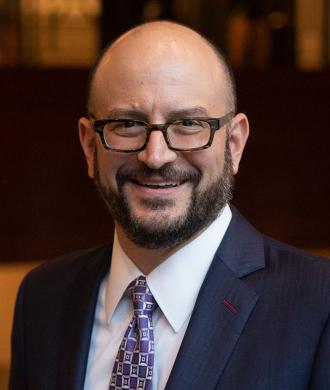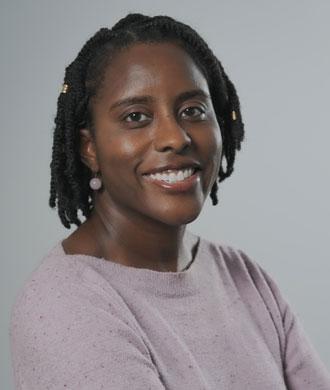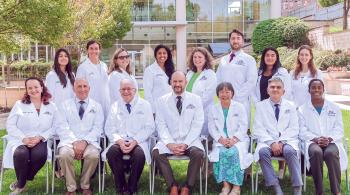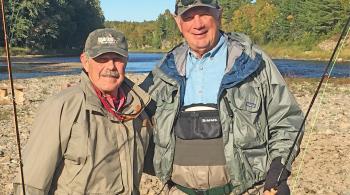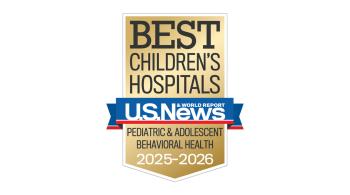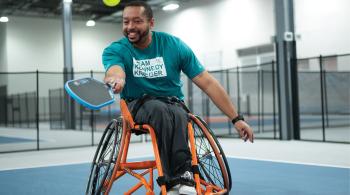Sickle Cell Disease
The focus of this podcast is on an aspect of sickle cell disease that doesn’t get as much attention as it deserves—the neurological and developmental implications of the disease. These conditions may severely impact children’s functional independence, mental health, quality of life and educational pursuits, and may increase their risk of future complications.
Dr. Bradley Schlaggar, president and CEO of Kennedy Krieger Institute, is joined by Dr. Eboni Lance. Dr. Lance is the medical director of Kennedy Krieger’s Sickle Cell Neurodevelopmental Clinic. She is also the associate director of the Institute’s Neurology and Neurogenetics Clinic. Dr. Lance is an associate professor of Neurology and Pediatrics at the Johns Hopkins University School of Medicine.
Dr. Schlaggar is also joined by Derek Robertson and Shanta Robertson--the Robertson’s, parents of children with sickle cell disease, are the founders and directors of the Maryland Sickle Cell Disease Association, an organization that was created to improve the lives of Marylanders with sickle cell disease.
Speakers for this month's episode include:
- Dr. Eboni Lance, medical director of Kennedy Krieger’s Sickle Cell Neurodevelopmental Clinic
- Derek Robertson and Shanta Robertson, founders and Directors of the Maryland Sickle Cell Disease Association
Learn More About Kennedy Krieger Faculty & Staff Members Featured in This Episode
Learn More About Kennedy Krieger Faculty & Staff Members Featured in This Episode
View Episode Transcription
Dr. Bradley Schlaggar (BS): Welcome to Your Child's Brain, a podcast series produced by Kennedy Krieger Institute with assistance from WYPR. I'm Dr. Brad Schlaggar, pediatric neurologist and president and CEO of Kennedy Krieger Institute. Sickle cell disease refers to a group of inherited disorders of red blood cells, that affects roughly 100,000 people in the United States alone. While the risk for sickle cell disease is greatest in people of African descent, about one in 365 black Americans have sickle cell disease, the disease crosses racial and ethnic boundaries and affects males and females in equal numbers. Sickle cell is a genetic disorder. People with sickle cell disease have inherited copies of genes from both parents. Thus, it's an autosomal recessive disorder. The genetic mutation directly affects the hemoglobin, the oxygen carrying molecule in our red blood cells, under the microscope, affected red blood cells take on a crescent or sickle shape, thus the name. These affected red blood cells do not do a good job of carrying oxygen to the body's organs like the lungs, liver, kidneys, muscles, and so forth, and that includes the brain. Today, our focus will be on an aspect of sickle cell disease that doesn't get as much attention as it deserves. The neurological and developmental implications that include strokes, seizures, and neurodevelopmental issues such as attention deficit, hyperactivity disorder, ADHD, specific learning disabilities, language issues, and executive dysfunctions. These conditions may severely impact children's functional independence, mental health, quality of life, and educational pursuits, and may increase their risk of future complications. Today I'm joined by one of my extraordinary colleagues at Kennedy Krieger, Dr. Eboni Lance. Dr. Lance is the medical director of Kennedy Krieger's Sickle Cell Neurodevelopmental Clinic. She's the co-director of the Institute's Neurology and Neurogenetics Clinic. Dr. Lance is an associate professor of Neurology and Pediatrics at the Johns Hopkins University School of Medicine. We are also quite fortunate to welcome Derek and Shante Robertson. The Robertsons, parents of children with sickle cell disease, are the founders and directors of the Maryland Sickle Cell Disease Association, an organization that was created to improve the lives of Marylanders with sickle cell disease. Welcome, Eboni, Derek, and Shante. Eboni, let's start with you. Some definitions. What is sickle cell disease? We touched on it briefly at the beginning, but what is it and what causes it?
Dr. Eboni Lance (EL): Sickle cell disease is an inherent disorder of red blood cells. It's caused by a genetic mutation in the hemoglobin molecule, which leads to these red blood cells having both a shortened lifespan, as well as difficulties with changing shapes. A lot of times the red blood cells can get stuck in the sickled shape, and then they get stuck in various blood vessels, and that can lead to a lot of the complications that we see associated with sickle cell disease.
BS: How common is it? I mentioned some aspect of the prevalence, but can you expound on that?
EL: Sure. It's important to think of sickle cell disease as a global disorder because it affects millions of people worldwide. That can particularly be true in different areas of the world, including Central and South America, the Caribbean, Sub-Saharan Africa, the Mediterranean, Saudi Arabia, and India in particular. It primarily impacts people of color in this country.
BS: How does it show up? What are the symptoms that typically present for sickle cell disease?
EL: One of the most common symptoms in sickle cell disease, pretty much the hallmark in terms of what people know about it is vaso-occlusive, or pain crisis. These pain crisis can occur in any part of the body and are associated with that sickling feature of the red blood cells, where again, they get stuck in these various positions. Sometimes that leads to blockages in various arteries or veins, blood vessels. Then that can lead to difficulties with the blood flow getting through and lead to pain. These pain crisis can be fairly severe and cause these patients to then have to go to the hospital and receive treatment from strong medications. A lot of patients have at least one sickle cell pain crisis a year. Some have more, some have less. But that's really one of the major complications associated with this disease. There are other complications as well. One of the common causes of death in sickle cell disease is when you have a sickling crisis involving the lungs, something called acute chest syndrome. That's something that can be fairly severe. Obviously it can impact your ability to breathe. A lot of times patients will have to go to the hospital and be hospitalized in an ICU setting in order to treat that. Then in addition to those crisis, there are several other complications associated with sickle cell disease that can affect the entire body. Those can range from stroke, seizures, headaches, to things that affect your learning and your behavior as well as that can impact your ability to walk, like avascular necrosis of the hips or bone crisis.
BS: You really describe a variety of types of symptoms and signs for sickle cell disease. Can you speak now to the variability? Are there patients who have mild, moderate, and severe forms? Of course, you mentioned that it can be fatal as well. There must be a severe end of the spectrum. But how variable is it and is there a way to predict who's going to have a mild course?
EL: Yes, so sickle cell disease can be very variable. It depends on the patient. It's very important to always listen to the patient in terms of describing their disease and how severe they feel it is. There are different subtypes of sickle cell disease. But again, it's difficult to predict who is going to have a more severe course versus who has a milder course. There are plenty of patients with sickle cell disease who almost never come to the hospital. Who are seen by their doctors maybe once a year just to check in, but really do quite well. Then there are other patients that are frequent visitors to the hospital or urgent care centers frequently need medical attention and treatment and have to be seen several times a year and receive disease modifying treatments and other therapies to help with their care. It's very difficult to predict in general, people say that one of the more common subtypes of sickle cell disease, homozygous SS type sickle cell disease is usually more severe. But there are other subtypes of sickle cell disease that can have just as severe manifestations. Again, it's important to focus on the individual, the patient, and their description of their disease.
BS: It's been nearly 50 years since New York started the first newborn screening program for sickle cell disease. That was 1975. In 1987, the National Institutes of Health came up with a consensus panel that recommended a new born screening for children. But it wasn't until nearly 20 years later in 2006, that newborn screening for sickle cell disease became available in all 50 US states. Can you speak to that newborn screening story and what has been the impact of screening in the newborn period for the diagnosis and treatment for sickle cell disease?
EL: With the introduction of the newborn screening, it really meant that for the first time, we could know from birth if a child had sickle cell disease or not. That's important because these patients are also predisposed to different infections, and infection was actually a very common cause of mortality in these patients before the newborn screening days. A lot of patients would actually die as children from these infections that would attack their entire body, in large part because the body was no longer protected by the spleen. The spleen usually collects red blood cells, cleans our blood supply. In patients with sickle cell disease, the spleen very quickly, very early in life, can get clogged by these sickled red blood cells. Once the spleen isn't functional, the body is predisposed to infection from encapsulated organisms or these very specific bugs that can make you very sick and in children can be very quickly fatal. Introducing sickle cell disease into the newborn screen allowed these patients from birth to be started on penicillin or other antibiotics which they take on a daily basis in order to protect them from these infections. It's led to a lot more patients surviving into adulthood, patients having a longer lifespan. We've had to grow and learn more about the disease and how it affects not just children, but young adults and adults, as well as geriatric adults as time has gone by.
BS: Derek and Shante, again, thank you for joining us. Can you tell us about your children, what their journey has been like and how they were diagnosed?
Shante Robertson (SR): Derek and I have three sons, two of whom live with sickle cell disease. Our oldest son is not affected by the disease and has always been a great support system for his brothers throughout the span of their having to manage their disease. Our two sons who have sickle cell disease are young men now and they're both college students preparing for life. Great guys. I'm very proud of our sons. Their experience or their journey living with sickle cell disease has been very interesting because our two sons who do live with sickle cell disease have had both quite a different journey. Our middle son, who was our first child born with sickle cell disease, has had a milder case as far as pain and some of the complications that individuals living with sickle cell disease have to deal with. He's had less of that. Our youngest has unfortunately had quite a few bouts with pain and hospitalizations. Fortunately, when he was introduced to hydroxyurea, which is a very important treatment for individuals living with sickle cell disease, that turned things around for him and has made managing sickle cell disease a lot better for him. But it's just been a wonderful experience being the mother of my sons and just being here to support the healthiest path for them while managing sickle cell disease.
BS: Did you have much experience with or understanding of sickle cell disease prior to learning of your son's diagnosis and then going on the journey that you're on now?
Derek Robertson: We had actually asked how our children were diagnosed and what Eboni spoke about with newborn screening. That was instrumental for us. When our sons were born, newborn screening and they were born in two different states. Our middle son was born in Texas and our youngest was born in Maryland and so in both instances our diagnosis came from the newborn screening program. So they were diagnosed pretty early. It ties into the question about the experience we had. Clearly with the second child, we had more of an expectation or that this was possible. I have a family history of sickle cell disease, so I had a brother. I grew up in Jamaica, and I had a brother who had sickle cell disease and he passed away at 18. Certainly was familiar with sickle cell disease and I knew I had sickle cell trait. Everybody mentioned the different types and I think you mentioned at the intro different types of sickle cell and Eboni mentioned SS. SS would be where both parents have sickle cell trait, the S gene and they come together. Well, I have the sickle cell trait, Shante has a thalassemia minor, a thalassemia trait. What we didn't know and I remember clearly as well that when you put sickle cell trait with thalassemia, you can still have sickle cell disease. Both our sons have sickle beta thalassemia and then leave it up to the docs like Eboni to make it even more complicated that there are two types of sickle beta thalassemia that we learned. There is sickle thalassemia plus and there's sickle beta thalassemia zero. Zero tends to be more severe. Our boys have sickle beta thal plus. But as Dr. Lance, Eboni, said earlier and Shante mentioned, the courses have been very different. But what's interesting just to point out is that a lot of times Shante and I say our middle son has had a different outward course because as parents with sickle cell, sometimes we don't know what's going on on the inside.
SR: In my experience with sickle cell, I remember growing up having a classmate who missed a lot of school. I remember asking once, what's going on? Is he sick? Someone mentioned, oh, he has something called sickle cell disease. That just stayed in my head and the backdrop of my mind. Fast forward, many, many years later because this was an elementary school to then have a child. Then when I met Derek, we knew he had a brother who had sickle cell disease who unfortunately passed away in his early adult years. That's when sickle cell came back up again in my head. But as Derek mentioned, neither of us never thinking that the thalassemia sickle cell trait that he had, the thalassemia trait that I had, would then produce a form of sickle cell disease. We just neither one of us, that never was even a consideration. I didn't have the personal family history as Derek did with his brother living with a disease. But I do remember that classmate quite clearly and missing a lot of school. That really played a role once we found out that our middle son had sickle cell disease. It really played a role in my wanting to learn as much as I could. I really didn't want our child's experience to be what I perceived my classmates experience, which missing a lot of school, missing a lot of time with friends. I really didn't want that to be the life for our child.
DR: I think it's clear, for us at least. We don't know if our reproductive decisions would have been any different.
SR: Absolutely not.
DR: Because sometimes we might talk about this later, but there's sometimes, I think what we really promote is what we call informed decision in reproductive decision making. It's much better from our personal experience to know what can be, but not that we would have necessarily made any different reproductive decisions.
BS: The point about missing a lot of school in the context of a chronic illness, that is a reality that can have implications for neurodevelopmental outcomes directly. But in addition, as we've talked about earlier on, sickle cell disease also has an effect directly on the brain. So Eboni, your work has focused on the neurodevelopmental aspects of cycle cell disease, can you tell us about the direct effects of sickle cell disease on brain function? We're going to get to talking about education down the road.
EL: Sickle cell disease can affect the brain in a few different ways. The way that most people know about is through brain injury. People with sickle cell disease have an increased risk for having stroke or having silent strokes, which can affect the brain and its function. We have different things that we do to try to assess their risk for stroke like transcranial dopplers, which certain patients with sickle cell disease get every year between the ages of 2 and 16.
BS: That's a way to look at blood flow to the brain basically.
EL: Yes. That's an ultrasound where they look at the speed of blood flow in the vessels in the brain and predict who is at highest risk for stroke. These children will get those ultrasounds and we'll be able to know who's at high risk. The patients at highest risk oftentimes go on transfusion therapy where they get transfusions every four to six weeks and that decreases the speed of that blood flow and decreases their risk for stroke. Unfortunately, transcranial dopplers do not work to predict risk for silent stroke. There is a lot of research going on about silent stroke currently, and how that impacts the brain because silent stroke usually involves smaller blood vessels in the brain.
BS: And the idea with silent stroke is that there's evidence on a brain image, say, that some brain injury took place due to a vessel that was occluded, but clinically, there was no obvious event like you typically think of with stroke per se.
EL: Yes, exactly. There were no hallmark symptoms that we typically associate with stroke. No weakness of one side of the body, no difficulties with speech, no trouble with one side of the face. However, there are more insidious or less obvious manifestations of silent stroke depending on what area of the brain is impacted. It's important to know that that is also something that people living with sickle cell disease are at increased risk for. Then in addition to brain injury, sickle cell disease also causes anemia. I mentioned earlier, that shortened life of those red blood cells. Anemia can also impact the brain, in particular, the developing brain. There's an impact of anemia on the brain of children and adults with sickle cell disease and we think that that's also impacting their learning, their behavior. That is something that we are also studying and trying to understand more, while at the same time trying to advocate for treatment of anemia.
BS: Your clinic is unique. It focuses on neurodevelopmental issues in sickle cell. It's unique to Maryland. Are there other such clinics around? Then in terms of the way you operate that clinic, how do you evaluate a child's status and needs?
EL: As far as I know, we are a standalone clinic for children and adults with sickle cell disease and neurodevelopmental issues. There have been other clinics in the past, but I do not think that they are currently active. A lot of hematology centers and sickle cell disease centers actually have neuropsychologists or behavioral psychologists, or neurodevelopmental physicians in their sickle cell clinics who see patients, but again, we stand alone and we accept patients from multiple centers. We have referrals from Johns Hopkins, primarily, but also see patients from Sinai Hospital, from Inova, from University of Maryland. Really from various hospitals in the Maryland, DC, and Virginia area. The way that we evaluate patients in our comprehensive clinic is we really try to use an interdisciplinary approach. I see all of the patients, and again, my training is in neurology and developmental medicine, so I try to see patients with that lens on. We have a neuropsychologist who does a lot of IQ testing as well as academic testing in these patients. Really trying to look at what their strengths and weaknesses are in terms of their abilities to learn. We have a behavioral therapist who talks to these patients about having a chronic disease, what coping strategies they can use to deal with that, and what other strategies they can use to help with, for example, missing school. To help with things that are very common in sickle cell disease, things like bed-wetting or nocturnal enuresis can be quite common. Then other things like pica or eating non-food items, is something else that's very common. Our behavioral therapist really targets those things. In addition to that, again, we have that interdisciplinary connection. We all talk to each other about these patients. We also have an educational specialist in our clinic who actually works with families to create school education plans and set up IEPs and 504 plans with the school. We have an adult neurodevelopmental provider as well as a child psychiatrist in our group.
BS: Let's talk a bit about the educational part of what you just described. The individualized education programs, children with sickle cell disease are eligible for such IEPs. What are the typical kinds of accommodations that might be needed to be made at school for children with sickle cell?
EL: Yes, these children are definitely eligible for IEPs and there are a lot of different accommodations available to them. From a purely medical standpoint, it's important that their hematologist weighs in on what needs they may have. There are a lot of cases where these patients need to be shielded from extreme temperatures. Maybe they don't go outside in the winter because that could precipitate a pain crisis, or maybe in extreme heat, they also don't go outside. It's important that they get frequent water breaks because dehydration can precipitate different complications associated with sickle cell disease. In addition, they will need frequent bathroom breaks as well, because they really do need to maintain their hydration. Then in addition to that, it's important to educate the school personnel and the school nurse about when an emergency might be occurring and when they may need to go to the hospital. I believe that Derek and Shante may have more to add on what Maryland specifically has done for children with sickle cell disease in terms of school programs.
BS: That's a great segue because I wanted to ask you both, Derek and Shante, what were your experiences at school? What were the challenges that you saw? Perhaps talk about, including the experience, if you went down that path, with individualized education programs as well.
DR: One of the important challenges for us, and I believe for many other parents, is having the information. We did not know what was open to us when we just started. It was actually another parent who mentioned to us about a 504 plan, IEPs. I think at the time, our children were in second and third grade. One of the things as well, one of the accommodations which became important for our children was having extra time to finish assignments, which was linked to the work that we were doing with Eboni. I think it's important to understand this and for parents to understand the difference between the 504 and the IEP because sometimes folks will think that their children are doing great in school or they get all As. They're getting As and Bs and so they don't need an IEP because sometimes IEPs are associated more with children who are perceived to have intellectual disabilities or they're struggling. As was explained to us, IEPs can actually change a curriculum. Instead of having to do three tests, you do one or something like that. But the 504 plan doesn't necessarily change a curriculum, but it can change accommodations for your child, and that was where we really looked at because one of the things in terms of having to come back to school, for example, with after a crisis, having to have a pillow that you can sit on because you had a pain in your back, wearing a hat in class because your head might be cold, sitting closer to the front because the attention may not be there, all of those things are in the 504 plan. Very early on, as Shante mentioned before, I think her emphasis was the experience for our children and really all children that we thought of that were going through this in school. I'll let Shante talk a little bit about the work she did and really spearheaded with the school nurses, and then I'll talk a little bit about the advocacy we did on the state level that affects everybody in Maryland.
SR: Yes. I can't stress enough how important it is to have a relationship with your school nursing team. Whether that be a nurse's aid who's there five days a week and a school nurse who comes in once a week, that relationship is really critical. They become your advocate in school for your child. Derek and I have always had a very strong relationship. To this day, I could see our son's elementary school nurse and we could still speak and say hello and recognize each other and have an appreciation for each other just because that relationship is built and recognizes the importance of that nurse or nurse's aid being the voice for your child when there's a substitute teacher in the classroom or even just educating and being in communication with the faculty there at the school and having a really clear understanding of what it means to successfully manage this disease in the school setting. I can't stress that enough. What we did to build up to getting the legislation that children living with sickle cell disease K through 12 in Maryland, which Derek is going to talk about, is we've really partner with our school faculty and everyone. We got everyone involved. We went in and asked the administration if we could in service the staff and basically everyone who had any type of interaction with our children in the school, whether that be the lunch room attendants, the playground attendants, whoever had some type of interaction with our children in the school, we wanted them to know about sickle cell disease and be free to ask questions. We were fortunate enough to have an excellent relationship with the pediatric nurses at Hopkins, and we had a nurse who would come out to the school at every level, elementary, middle, and high school, and just talk to the staff about sickle cell disease and how that looks in the school setting and what are some of the important things to consider and to be aware of. That was really, I think the biggest thing that we did in the school was just to provide that education.
DR: One anecdote that advocacy led to as one of the more serious crisis that our youngest son had, was actually identified early by a recess monitor who just saw him looking a little bit more fatigued and was able to call the nurse and they called us and he ended up being in hospital for almost a week, but it could have been a lot worse. We actually brought together the state school nurses. We got on their agenda. Shante got the School Nurses Association for the statewide. What we did on the statewide level, we had, thankfully, and I can't say this without mentioning her, a State senator, Senator Shirley Nathan-Pulliam who's now retired. She approached us and said, "Hey, do you know that there are guidelines for asthma in school and there are guidelines for juvenile diabetes in the schools. Why don't we have something for sickle cell disease?" That was really the impetus. She helped us craft some legislation, and that legislation passed, which in essence says that if you're K through 12 and you identify with sickle cell disease, the school has to put in a school management plan for the child. Essentially, it's an individualized health plan. We talked about the 504, but this is an individualized health plan that outlines all the different steps that they need to take. These guidelines were written with Dr. Lance's help and are now posted on both the Department of Education and the Department of Health websites. The nurses have actually gone through training. It's training that they go through during the summer when the kids are off and they're doing their professional education. That's part of the training going into this every school year. One of the things I think we learned from folks like Eboni was that the teachers can play a real integral part in identifying that change in behavior. A child that was getting As and Bs and is suddenly getting Cs and Bs or struggling a little bit, and there's some change, she talked about those insidious changes, the school system is so important there because they see them more than we do. When they're at that school age, they're between going to childcare and then you go to school and then you have aftercare because many of us have to work and you're picking up your kids at 5:00 o'clock. They can see that, and so that was why we thought it was so important to have them identify some of the things to look up for in children with sickle cell disease. That legislation is in effect. It was in effect since 2019. It was actually being implemented when COVID hit in the spring of 2020. But it's still there and we feel very proud of that legislation, and we think it's going to make a big difference for children in the school set up.
BS: It's really consequential legislation. On behalf of all of us, thank you for championing it, and Eboni for your work and bringing it to fruition, consequential because it affects so many lives. Your point about school too. You're talking to a couple of child neurologists here with me and Eboni. We both know that the real action for cognitive development is happening in the school, not by coming to see us a couple times a year, but being in school, having the opportunity to learn and develop. So every effort to make sure that happens and happens effectively and safely is the highest priority. Eboni, let's talk about, you mentioned some of the research that's going on, and I think Shante mentioned hydroxyurea. There are other treatments out there that have effectiveness for sickle cell. Where are we on the treatment front and is there a cure?
EL: For years it had primarily been hydroxyurea and transfusion therapy for sickle cell disease, but in the last decade or so, there have been a lot of new treatments for sickle cell disease that have been popping up. These are disease-modifying therapies, primarily, not necessarily curative therapies, but these are things that can improve the lives of patients with sickle cell disease, and so there are a lot of new treatments that are out there that are being used to support these patients. There are curative treatments as well. One of the original ones is bone marrow transplants, which can be used in a subset of the population. But there's a lot of research going on to try to expand who can receive bone marrow transplants and to try to make the regimen for receiving a bone marrow transplant a little bit easier to endure to withstand, so that more people can have this curative treatment. In addition to that, there are a few genetic therapies that are being developed that can also be curative for sickle cell disease. That's something that's very exciting, that's being championed by a lot of people, and so there are new therapies coming down the pipeline as we speak.
DR: When our son was in the hospital, you really feel helpless because you're really just talking about pain management at the time. Are you going to increase the morphine or lower the morphine? It's not easy as parents, it's not easy for the child to go through it, but it's not easy to see your child in pain and not being able to do anything about it. It's a hopeful time for sickle cell disease. Cure is a very big word, and I think how we look at it and define it. For example, one of the gene therapies that Dr. Lance mentioned is looking to increase the fetal hemoglobin, which is what hydroxyurea does. I think the studies have shown that if you can increase the hemoglobin that you get from your mom, and this is a layperson's interpretation, it provides protection for children with sickle cell disease for some time. But then we naturally lose that fetal hemoglobin as we come into adulthood, hydroxyurea raises that fetal hemoglobin. One of the gene therapies, they're trying to turn off the gene that stops the production of fetal hemoglobin. One could say is that a cure per se, but I don't know if that's what the goal is. The goal is really to make sure that you're not symptomatic. If you can get the fetal hemoglobin up to a level that you're not symptomatic and you're not having the challenges, you're probably living more like somebody who has sickle cell trait. As we talk about cure for many disorders, I think we have to really look and say, what does that really mean? For us, not everybody is going to be eligible for these "cures" because you have to have this delicate balance between somebody who is sick enough and somebody who can get it. Our children may not be eligible for that because Dr. Lance mentioned the conditioning that you have to go through. You have to wipe out your red blood cells. It's chemotherapy. Ethically, physicians may say, "I don't want to put you through that because your life is just not at that level that you want to do that." We have to really work on making sure that conditioning is more palatable for everybody. For us and many of us with sickle cell disease, the disease modifying therapies are what I think can make a huge difference. I think of other diseases that have therapy, HIV I think is a really good example. In the early days that was really a fatal disease. Now people are looking at HIV more as a chronic illness. That's where we're really hoping that as these therapies come out, that will increase hemoglobin levels that will reduce the number of pain crisis. We're very hopeful for that.
BS: Can you, Derek or Shante, just take a minute to tell us a little bit about the origins of the Maryland Sickle Cell Disease Association? Because we'd like also to be able to put a link to the organization on the web page for this episode. Just perhaps a little bit of a background on where the notion of the association came from.
DR: I think it started out just as an idea that we wanted to be able to link. We saw very early on that there was a link between the hematologist, our primary care physician, and emergency room where we knew that that was, unfortunately, we spent a lot of time in emergency room. So we put on a forum and the attendance was just really great. I think we both had backgrounds in patient advocacy. I worked and still worked for several years in hemophilia. I saw firsthand how patient advocacy in that disease state through chapters made a huge difference. Shante was working in the pharmaceutical sales industry and she saw from that perspective the importance of patient advocacy. I think that that's what really gave rise to say we really wanted to advocate for not just our children, but really just looking at the community and seeing that we could make a difference with the patient voice. That, I think, was the impetus with the Maryland Sickle Cell Disease Association.
SR: I think also, in addition to all those things that Derek mentioned, we also saw a need to have a voice for the community, and also helping the community to understand what's out there to be educated on. We just finished talking about a lot of great new modifying therapies and potentially curative therapies on the horizon. Well, in order for those therapies to be of use, you have to have a community that will accept those therapies, and that community needs to be educated. That really is a really big role of community-based organizations, I feel, to educate the community. Not to push a decision one way or the other, but just to make sure the community has all of the necessary information to make the most informed decision about those therapies. That was another driving reason for having our organization, was really to make sure the sickle cell community is very well-informed and educated.
BS: Eboni, I'm going to end with this question for you to mention a little bit about research. Can you tell us a little bit about the research that you're doing right now, and opportunities for people listening, and to potentially participate?
EL: Sure. We have several research studies ongoing at this time in sickle cell disease, and all of our research is informed by, or inspired by the patients that we take care of. We have a study for young children with sickle cell disease, where we're trying to identify what puts them at risk for brain injury or for cognitive difficulties. We are recruiting for that actively, and those children will receive cognitive testing, MRIs, as well as a neurological exam. Then we have studies looking at hearing loss and balance issues in children and adults with sickle cell disease. One part of that study is a survey, and another part is where they come in and actually receive hearing and balance testing as part of that study, so we're actively recruiting there as well. Then we have another study for adults with sickle cell disease, where we are trying to identify what is a good test that we can use to screen for cognitive issues in adults with sickle cell disease. Those patients would get a cognitive screening test as well as full cognitive testing so that we can identify the best tools to use in clinic to identify those patients that may be higher risk and may require a little bit of a closer look in terms of an MRI or additional testing to really figure out what might be going on and impacting them in their daily life and ability to function.
BS: We can post information about those studies as well on the page for this episode. Thank you to our guests and to you our listeners. We hope you have found this discussion of sickle cell disease and the brain informative and helpful. Please check out our entire library of topics on your child's brain at Wypr.org, KennedyKrieger.org, Wypr.org/Studios, or wherever you get your podcasts. Your Child's Brain is produced by Kennedy Krieger Institute with assistance from WYPR and producer Spencer Bryant. Please join us next time as we examine the mysteries of your child's brain.

